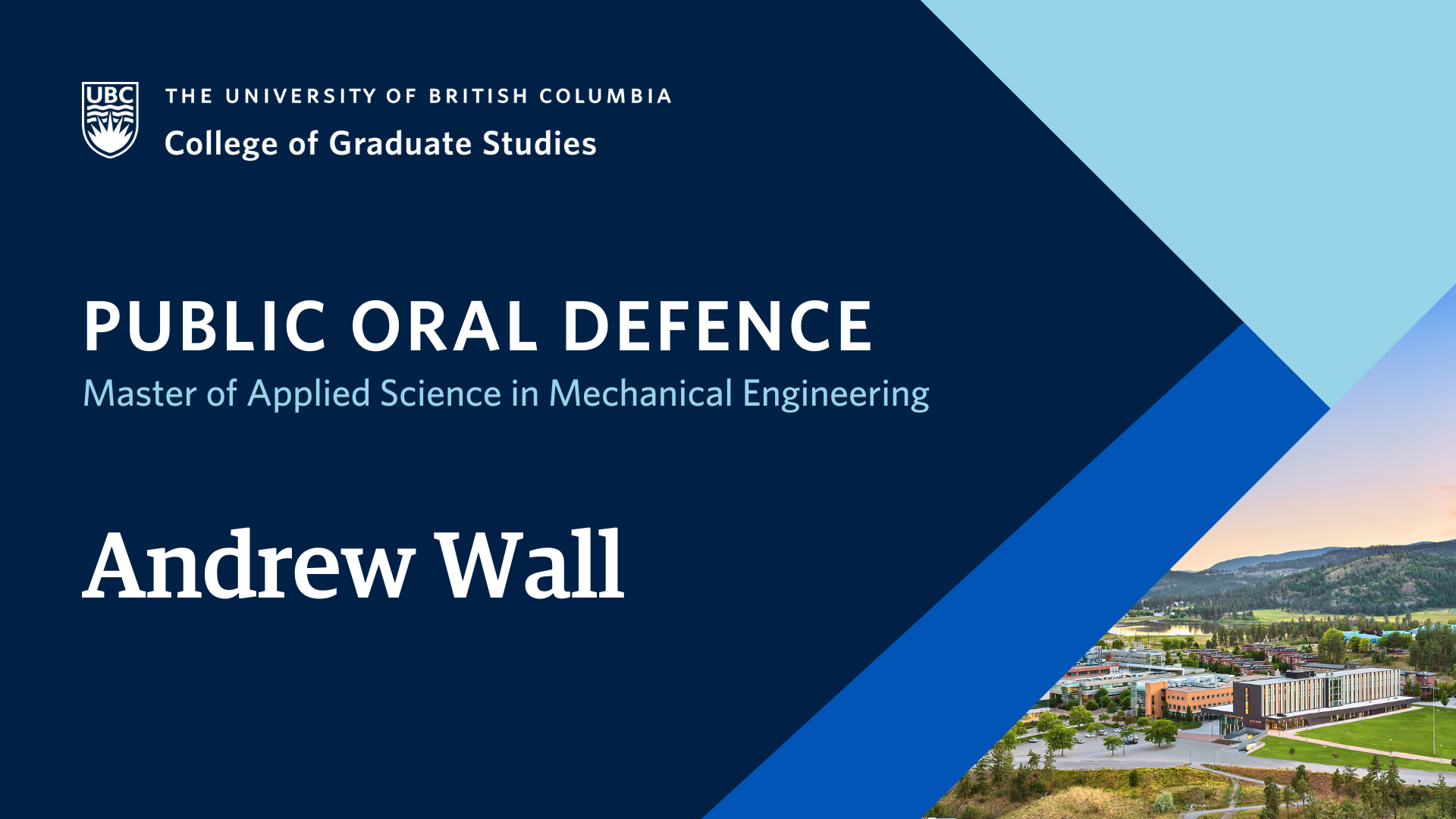
- This event has passed.
Thesis Defence: On the Development of a Novel Solidification Crack Test for Additive Manufacturing
August 29, 2023 at 1:00 pm - 4:00 pm

Andrew Wall, supervised by Dr. Michael Benoit, will defend their thesis titled “On the Development of a Novel Solidification Crack Test for Additive Manufacturing” in partial fulfillment of the requirements for the degree of Master of Applied Science in Mechanical Engineering.
An abstract for Andrew Wall’s thesis is included below.
Defences are open to all members of the campus community as well as the general public. Please email michael.benoit@ubc.ca to receive the Zoom link for this defence.
ABSTRACT
Additive manufacturing (AM) is a rapidly evolving industry, and with new advancements in the technology, research into the many unique challenges facing widespread adoption of additive processes is well under way. Solidification cracking (SC) is a metallurgical defect that occurs during the solidification of alloys in processes such as welding, casting, and now additive manufacturing. SC can cause significant mechanical deterioration in parts in which it is present, and it remains a significant hurdle for AM processes. Research into the causes, effects, and mitigation strategies of SC in AM is ongoing, however strategies of analysing SC and quantifying the results is inconsistent across studies, unlike in casting and welding which have developed standard testing procedures over the decades of industrial use. If AM is to garner widespread adoption in industrial uses, standardised methods of testing need to be developed in order to accurately compare results across studies and provide reliable information of SC susceptibility for a given material, process, or set of parameters.
The research conducted in this thesis presents a first-of-its-kind design for a method of SC susceptibility analysis for AM processes. A benchmark specimen, developed with the design philosophies of several casting and welding tests in mind, has been produced using laser directed energy deposition (L-DED) in order to assess the viability of a self-restraint test that can promote cracking in a repeatable and quantifiable manner. The design aims to be simple yet robust in order to be applicable to a wide range of AM processes and parameters. The design consists of several individual ‘legs’ printing alongside one another before tapering towards one another and joining, with subsequent layers producing the ‘roof’ of the sample that joins the individual legs. Finite element simulations were conducted to confirm the thermal and stress development in the sample throughout printing and clear regions of increased stress and strain were found along the intersections of where two legs join. Two initial samples were produced using Inconel 625 powder for repeatability analysis, and a sample produced using Inconel 718 powder was used as a comparative analysis to assess the specimen’s ability to distinguish between material composition. Samples were analysed using optical microscopy to assess cracking in the samples. It was found that the initial design was capable of producing cracks at the legs intersections with repeatable results, and cracks formed in the Inconel 718 sample were less severe than the cracks produced in the Inconel 625 samples which is consistent with documented crack susceptibility differences between the two materials. The cracks were quantified based on the vertical length from the base of the crack to the tip, as well as the total length of the crack including deviations. The ratio of these two lengths was also recorded and produced highly repeatable results (0.8 – 0.9), suggesting a potential method of result quantification using a dimensionless susceptibility index. The cracks, however, were determined to propagate transgranularly, and as SC is an intergranular defect, they were determined to be ductile fractures that initiated in the solid-state. Despite the failure to produce consistent SC, the ability to produce cracking at specified locations with repeatable results indicates a likelihood that further improvements to the design may allow for consistent SC susceptibility analysis. This initial design serves as a foundation for further development for more specified testing methods, either for individual AM processes, or for crack initiation modes other than SC.
A preliminary redesign of the initial specimen is presented to address the issues facing the initial design. Changes to dimensions were made to improve printability, as well as reduce stress concentration at the leg intersections in order to reduce the likelihood of solid-state cracking in favour of promoting SC initiation modes. Additionally, each leg was produced with varying widths in order to promote varied stress concentrations at each leg intersection with the aim to develop regions of increasing crack susceptibility, similar to tests in casting and welding such as Constrained Rod Casting and the Houldcroft test, respectively. The design faces issues regarding the resolution of various AM processes, as minor changes in specimen geometry are difficult to accurately capture with processes such as DED, and as such the effectiveness of a particular design is highly variable depending on the AM process used to manufacture it. Due to this, benchmark specimens designed specifically for a particular AM process may be necessary for accurate SC susceptibility analysis, however the design concept presented in this research can serve as the first step in process-specific test development, as its simplicity allows it to be easily modified to better suit desired applications.
The results of this research provide a first step towards standardisation of a severe metallurgical defect in AM. Standardisation of AM testing is a necessary step for widespread industrial adoption, as inconsistent result quantification makes comparison between studies difficult and hinders industrial confidence in the process. This first step may be used for further SC susceptibility test development in AM, however the presented design may also serve as a basis for non-SC fracture modes, such as the solid-state cracking observed in the initial samples.